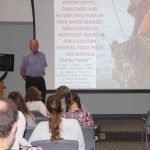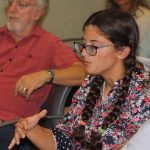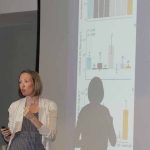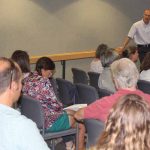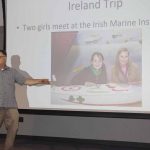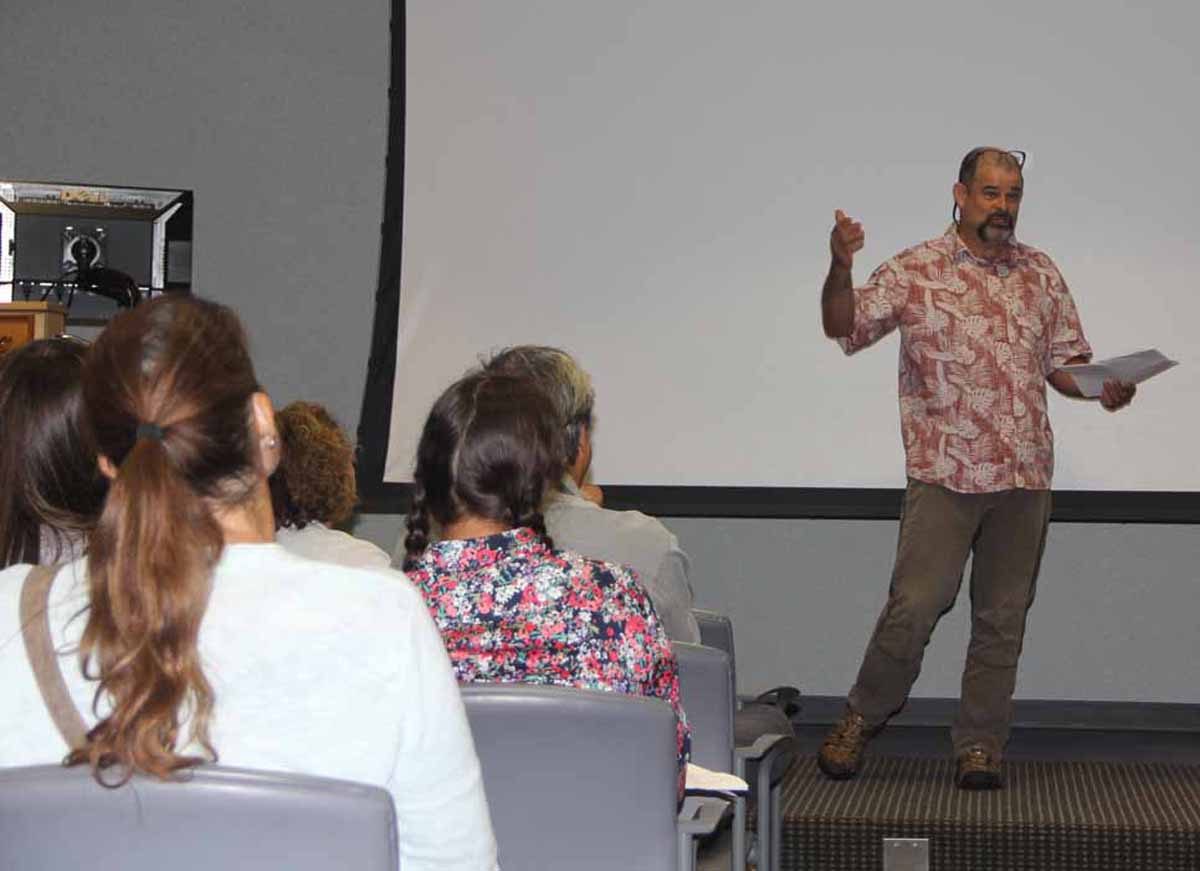
Story and photos by Judy Benson
Groton – Without the work of scientists in the field, polluted runoff from the Yankee Doodle Bridge on I-95 would have continued flowing into the Norwalk River, threatening some of Connecticut’s largest and most productive commercial shellfish beds.
But because a Connecticut researcher had previously sampled and tested the river and sediments near the bridge, evidence of oil, gasoline and other contaminants getting into the waterway was readily available to present to state transportation officials at a critical time in planning for the $14.7 million project, according to Long Island Soundkeeper Bill Lucey.
“We said, ‘here’s the science,’” said Lucey. “Now we have the first bridge in Connecticut getting a stormwater collection system. This is how science benefits society and becomes a real policy change.”
The keynote speaker at Connecticut Sea Grant’s 30th Anniversary Research Forum on Sept. 7, Lucey used the anecdote about the bridge project as an example of how the work of scientists provides the foundation he and other environmental advocates need to persuade lawmakers to take actions that benefit Long Island Sound and its watershed. As a result of that research, the bridge project now includes equipment to capture and treat runoff from the road surface on the bridge, Lucey said.
In a phone interview after Lucey’s talk, Robert Nowak, project engineer for the state Department of Transportation, said that while it’s an overstatement to say no other Connecticut bridges have runoff collection systems, “we did make a better effort (on the Norwalk bridge) to contain as much water as we could.”
Still, Lucey’s comments highlight how research can make a positive impact on real-world decisions.
“We need to keep this scientific effort funded and well-focused,” said Lucey, who joined the staff of the Connecticut Fund for the Environment/Save the Sound as Soundkeeper in 2017, advocating for water quality improvements, fish and other wildlife as well as the people who work on and enjoy the estuary.
His comments served as a framework for the 14 presentations in the daylong forum at UConn’s Avery Point campus, attended by about 50 fellow researchers, students and members of the public. Topics ranged from seaweed and ornamental fish aquaculture to climate change effects on marinelife, coastal wetlands, property values and real estate law to the trans-Atlantic journey of an unmanned sail drifter. But all were connected by a common thread: funding support from Connecticut Sea Grant underscored by a commitment to sharing the results of their research with the community.
“This forum gives us a chance to showcase some of the best science going on in Connecticut,” said Syma Ebbin, Sea Grant’s research coordinator and organizer of the forum. “And in addition to producing this cutting-edge science, these projects enable our next generation of scientists to be trained, providing graduate, undergraduate and even high school students with hands-on research experience.”
The morning began with a presentation by Jacob Kasper, a UConn doctoral student who is part of a team researching alternative management strategies for Long Island Sound tautog, also called blackfish. An overfished species, tautog populations would benefit from a slot limit, Kasper and his colleagues concluded. That would allow fishermen to keep only fish that are between 16 to 19 inches long, rather than bigger fish that produce more and larger eggs with higher survival rates.
“You allow the big fish to be released, because old fish make more and better offspring,” he said.
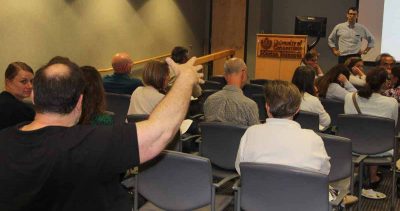
UConn Prof. Charles Yarish next gave an overview of the genesis of seaweed farming in Long Island Sound through basic and applied research, which has been supported by Sea Grant over the past 30 years. Vince Vacco from the Mystic Aquarium spoke about an ongoing collaboration with the Marine Sciences Magnet High School in Groton focused on aquarium fish aquaculture. Tom Savoy with the Connecticut Department of Energy and Environmental Protection spoke about endangered Atlantic sturgeon in the Connecticut River and genetic analysis of juveniles that was supported by Sea Grant. It proved the existence of breeding populations of the species in the river.
Christopher Murray, a UConn doctoral student working with marine sciences Prof. Hannes Baumann and others on the sand lance research, noted that this species is “one of our most important forage fish, especially on the Stellwagen Bank.” Their work shows that survival rates for sand lance embryos declined with increases in carbon dioxide and water temperatures that are predicted to occur with climate change.
“These species are highly sensitive to near future CO2 levels and warming temperatures,” he said.
Climate change effects were also the focus of three projects on copepods – tiny crustaceans that are essential to the marine food web. These were described in talks given by UConn professors Michael Finiguerra and Hans Dam, and doctoral student James deMayo.
“They are the most abundant animals on the planet,” said Dam. “No copepods, no fish.”
Another study examined how coastal wetlands, which play an important role as sinks for greenhouse gas emissions, are affected by restoration of tidal flows, sea level rise and other factors. The research is ongoing, said Prof. Ashley Helton of the UConn Department of Natural Resources and the Environment, one of the scientists leading the project.
“We want to find out how shifts in salt marsh vegetation will alter the ecosystem services,” being performed by coastal marshes in urban areas, she said.
Grant McCardell, a postdoctoral research associate in UConn marine sciences, described long-term work that began with Sea Grant funding in 2010 that combines satellite sea surface temperature data with a hydrodynamic model to better estimate seasonal changes in Long Island Sound water column temperatures.
Other projects dealt with challenging and inspiring human interactions with the environment. These included an analysis by Clark University economics Prof. Robert Johnston showing an 11 percent decline in property values in flood zones up to one-quarter of a mile from the shoreline in five Connecticut counties from 1991 to 2014. Read Porter, senior staff attorney at the Marine Affairs Institute at the Rhode Island Sea Grant Legal Program, presented the findings from research conducted by Sea Grant-supported interns on how legal issues generated by coastal erosion and flooding due to sea level rise have been addressed by case law and policy. Michael Dietz, Sea Grant extension educator and director of NEMO (Nonpoint Education for Municipal Officials) shared a project in which student interns worked with the town of Newington to determine which public spaces could be retrofitted with stormwater infrastructure to collect and filter runoff.
“Towns are in need of help like this,” Dietz said.
The forum ended with the inspiring tale of the Lancer told by Waterford High School teacher Michael O’Connor. He recounted the story of how the unmanned sail drifter built by student Kaitlyn Dow as part of a year-long project on ocean currents eventually landed in Ireland and led to a cross-cultural exchange. After a second trans-Atlantic voyage, the Lancer is now at a school for creative arts in Plymouth, England, and is slated to be re-released this year.
“Our mission is to generate and provide science-based information and tools that can help Connecticut residents and communities balance diverse coastal and marine interests and adapt to changing conditions,” said Nancy Balcom, associate director of Connecticut Sea Grant. “As you can see by the breadth of the talks included in this research forum, Sea Grant support in the form of large research grants and small development awards enable important and relevant issues in the areas of fisheries, aquaculture, coastal ecosystems, resilient communities, environmental literacy and workforce development to be addressed.”
She added: “We are further gratified that many researchers have been able to use the results of their Sea Grant-supported work to successfully leverage additional grants to further their investigations.”
Judy Benson is the communications coordinator at Connecticut Sea Grant.

